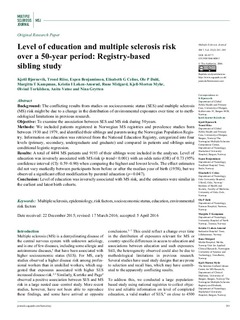| dc.contributor.author | Bjørnevik, Kjetil | |
| dc.contributor.author | Riise, Trond | |
| dc.contributor.author | Benjaminsen, Espen | |
| dc.contributor.author | Celius, Elisabeth Gulowsen | |
| dc.contributor.author | Dahl, Ole-Petter | |
| dc.contributor.author | Kampman, Margitta Theodora | |
| dc.contributor.author | Løken-Amsrud, Kristin Ingeleiv | |
| dc.contributor.author | Midgard, Rune | |
| dc.contributor.author | Myhr, Kjell-Morten | |
| dc.contributor.author | Torkildsen, Øivind | |
| dc.contributor.author | Vatne, Anita | |
| dc.contributor.author | Grytten, Nina | |
| dc.date.accessioned | 2017-05-18T07:28:59Z | |
| dc.date.available | 2017-05-18T07:28:59Z | |
| dc.date.created | 2017-01-09T15:53:08Z | |
| dc.date.issued | 2016 | |
| dc.identifier.citation | Multiple Sclerosis. 2016, 23 213-219. | nb_NO |
| dc.identifier.issn | 1352-4585 | |
| dc.identifier.uri | http://hdl.handle.net/11250/2442701 | |
| dc.description.abstract | Background:
The conflicting results from studies on socioeconomic status (SES) and multiple sclerosis (MS) risk might be due to a change in the distribution of environmental exposures over time or to methodological limitations in previous research.
Objective:
To examine the association between SES and MS risk during 50 years.
Methods:
We included patients registered in Norwegian MS registries and prevalence studies born between 1930 and 1979, and identified their siblings and parents using the Norwegian Population Registry. Information on education was retrieved from the National Education Registry, categorized into four levels (primary, secondary, undergraduate and graduate) and compared in patients and siblings using conditional logistic regression.
Results:
A total of 4494 MS patients and 9193 of their siblings were included in the analyses. Level of education was inversely associated with MS risk (p trend < 0.001) with an odds ratio (OR) of 0.73 (95% confidence interval (CI): 0.59–0.90) when comparing the highest and lowest levels. The effect estimates did not vary markedly between participants born before or after the median year of birth (1958), but we observed a significant effect modification by parental education (p = 0.047).
Conclusion:
Level of education was inversely associated with MS risk, and the estimates were similar in the earliest and latest birth cohorts. | nb_NO |
| dc.language.iso | eng | nb_NO |
| dc.publisher | SAGE Publications | nb_NO |
| dc.rights | Navngivelse 4.0 Internasjonal | * |
| dc.rights.uri | http://creativecommons.org/licenses/by/4.0/deed.no | * |
| dc.title | Level of education and multiple sclerosis risk over a 50-year period: Registry-based sibling study | nb_NO |
| dc.type | Journal article | nb_NO |
| dc.type | Peer reviewed | nb_NO |
| dc.description.version | publishedVersion | |
| dc.source.pagenumber | 213-219 | nb_NO |
| dc.source.volume | 23 | nb_NO |
| dc.source.journal | Multiple Sclerosis | nb_NO |
| dc.identifier.doi | 10.1177/1352458516646863 | |
| dc.identifier.cristin | 1423666 | |
| dc.description.localcode | © The Author(s), 2016. | nb_NO |
| cristin.unitcode | 194,65,1,0 | |
| cristin.unitname | DMF fakultetsadministrasjon | |
| cristin.ispublished | true | |
| cristin.fulltext | original | |
| cristin.qualitycode | 1 | |

